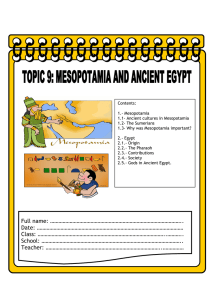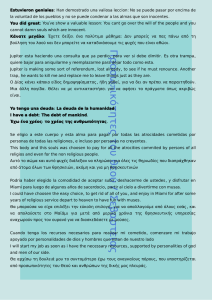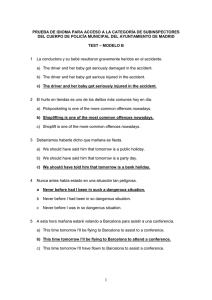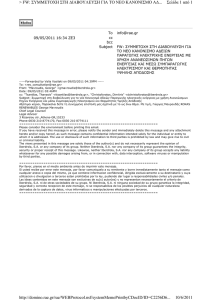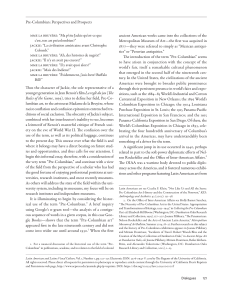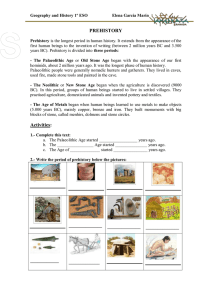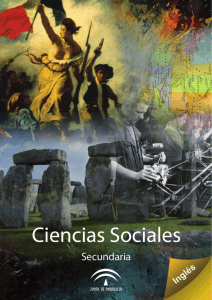Subido por
Manaen Eliacim Ayala Orantes
Melchizedek: Priesthood, Kingship & Divine Rule in Ancient Near East
Anuncio
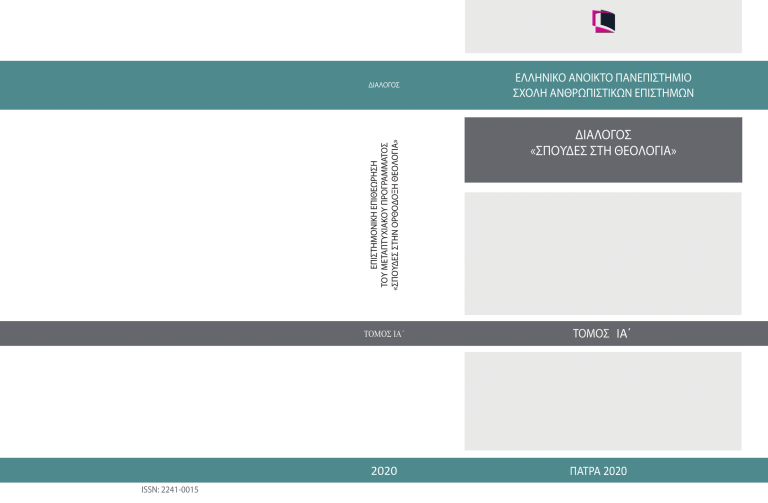
Παναγιώτης Καμπούρης, ∆ρ Η ιεροσyνΗ του Μελχισεδeκ σε βιβλικeσ και εξωβιβλικeσ πΗγeσ και Η συνaφειa τΗσ Με τΗν θεϊκh βασιλεiα τΗσ αρχαiασ εγγyσ ανατολhσ c Περίληψη d το άρθρο αυτό σκιαγραφεί την βιβλική φυσιογνωμία του θεοφόρου Μελχισεδέκ ως βασιλιά της αρχαίας πόλης σαλήμ και ιερέα του υψίστου θεού. πραγματικά, μια έντονη αναφορά στον «βασιλιά της δικαιοσύνης» ( )צדקמלכיγίνεται στο Γεν 14, 18-24, όπου υπογραμμίζεται η βαθιά θεολογική σημασία της συνάντησης του Μελχισεδέκ με τον πατριάρχη αβραάμ. ωστόσο, η αινιγματική προσωπικότητα του Μελχισεδέκ –που προεικονίζει τον Μέγα αρχιερέα, τον ι. χριστό– αναφέρεται τόσο στην μεσσιανική προφητική ρήση του βασιλικού Ψαλμού 109 όσο και στον απόστολο παύλο (Εβρ 5, 5-6· Εβρ 7, 3). ακόμη, εξετάζονται και άλλες αναφορές για τον μυστηριώδη Μελχισεδέκ από την μη βιβλική σφαίρα και πιο συγκεκριμένα από το βιβλίο των Ιωβηλαίων και το βιβλίο του Β΄ Eνώχ (Ιωβ 13, 22-28· Β΄ Eνώχ κεφ. 69-73). επιπλέον, ο Μελχισεδέκ αναφέρεται στο απόκρυφο έργο Ψευδο-Ευπόλεμος, στις Ελληνιστικές Προσευχές της Συναγωγής, αλλά και σε κείμενα του κουμράν, στο Χειρόγραφο του Ενδέκατου σπηλαίου (11QMelch) και στο Απόκρυφο της Γένεσης (1QapGen). εξάλλου, το όνομα του Μελχισεδέκ αποκαθίσταται ως η πιο πιθανή ανάγνωση και σε άλλα δύο αποσπασματικά έργα της εσσαιο-κουμράνειας κοινότητας: στην Διαθήκη Αμράμ (4Q’Amrambar), καθώς και στους Ύμνους για την Θυσία του Σαββάτου (4QShirShabb). επίσης, ο φίλων ερμηνεύει το όνομα Μελχισεδέκ ως “βασιλεύς τῆς εἰρήνης”, “βασιλεύς δίκαιος” (Νομ. ιερ. αλληγ. 3, 79-82· Περί προπ. συν.99, 4· Περί Αβραάμ 235, 4-5), ενώ αναφορά στον Μελχισεδέκ γίνεται και από τον ιώσηπο (Ιουδπολ 6, 438· ΙουδΑρχ 1, 179-181). στη συνέχεια, μελετάται διεξοδικά η ιεροσύνη στον πολιτισμό και την θρησκεία των σουμερίων και των βαβυλωνίων, αλλά και στον πολιτισμό 124 ΔΙΑΛΟΓΟΣ «ΣΠΟΥΔΕΣ ΣΤΗ ΘΕΟΛΟΓΙΑ» - ΤΟΜΟΣ IA΄ των χετταίων και των αρχαίων αιγυπτίων. επιπροσθέτως, επισημαίνεται εκτενώςκαι το ζήτημα της θεϊκής βασιλείας στους προαναφερθέντες λαούς της αρχαίας εγγύς ανατολής. Άλλωστε, στην αρχαία αίγυπτο οι μεγαλοπρεπείς βασιλιάδες (οι φαραώ) είχαν θεϊκή προέλευση· κάτι παρόμοιο παρατηρείται στην βαβυλώνα, όπου ο βασιλιάς χαρακτηρίζεται ως νικηφόρος πολεμιστής που νίκησε τους εχθρούς του. Μάλιστα, στον πολιτισμό των χετταίων, καθώς και στην αρχαία ουγαρίτιδα, ο βασιλιάς περιγράφεται ως γιος του θεού. τέλος, η ιεροσύνη του Μελχισεδέκ συνδέεται αναμφίβολα με την θεϊκή βασιλεία της αρχαίας εγγύς ανατολής. Με άλλους λόγους, παρατηρείται μια γενετική σχέση μεταξύ του ονόματος Μελχισεδέκ και της ιεροσύνης, της βασιλείας και της δικαιοσύνης στον χώρο των κοινωνιών της αρχαίας εγγύς ανατολής. Λέξεις - Κλειδιά: Ιεροσύνη, εξωβιβλικά έργα, Μελχισεδέκ, κουμρανικά κείμενα, θεϊκή βασιλεία, λαοί της αρχαίας Εγγύς Ανατολής c Abstract d This paper outlines the biblical physiognomy of theophoric Melchizedek as king of the ancient city of Salem and priest of the Most high God. in fact, a vivid reference to the “king of righteousness” ( )מלכיצדקis made in Gen 14, 18-24, where it is underlined the profound theological significance of Melchizedek’s encounter with patriarch abraham. however, the enigmatic personality of Melchizedek –depicting the high Priest, J. Christ– refers to both the messianic prophetic saying of royal Psalm 109 and the apostle Paul (Heb 5, 5-6; Heb 7, 3). also, andother references from the non-biblical realm about the mysterious Melchizedek are examined and more specifically from the book of Jubilees and the book of 2 Enoch (Jub 13, 22-28, 2 Enoch 69-73). in addition, Melchizedek refers to the apocryphon work PseudoEupolemus, in Hellenistic Synagogal Prayers but in the Qumran texts, too, 11Q Melch and in Apocryphon of Genesis(1Q apGen). yet, the name of Melchizedek is restored as the most probable reading in two other fragmentary works of the essaio-Qumran community: in the Amram Covenant (4Q’ Amrambar), as well as in the Hymns for the Sabbath Sacrifice (4Q ShirShabb). even more, Philo interprets the name Melchizedek as “king of peace”, “righteous king” (Leg. 3, 79-82; Congr. 99, 4; Abr. 235, 4-5), while referring to Melchizedek is also done by Josephus (JW 6, 438; Ant. 1, 179-181). 125 Α: ΜΕΛΕΤΕΣ / ΠΑΝΑΓΙΩΤΗΣ ΚΑΜΠΟΥΡΗΣ Then, the priesthood in the culture and religion of the Sumerians and Babylonians is carefully studied, but also in the culture of the hittites as well as in ancient egypt. in addition, extensive reference is made tothe issue of the divine kingship in the aforementioned peoples of the ancient Near east. in fact, in ancient egypt majestic kings (the pharaohs) had a divine origin; something similar is observed in Babylon where the king was described as a victorious warrior who defeated his enemies. Nevertheless, in the civilization of the hittites as well as in that of ancient Ugarit the king was described as the son of god. Ultimately, Melchizedek’s priesthood is undoubtedly associated with the divine kingship of the ancient Near east. in other words, a genetic connection is observed between the name Melchizedek and the priesthood, the kingship and the righteousness in the realm of the ancient Near eastern societies. Key words: Priesthood, extra-biblical writings, Melchizedek, Qumran texts, divine kingship, ancient Near Eastern peoples. * Panagiotis L. Kampouris The PrieSThood oF MeLChizedeK iN BiBLiCaL aNd exTra-BiBLiCaL SoUrCeS aNd iTS reLeVaNCe To The aNCieNT Near eaSTerN diViNe KiNGShiP The “king of righteousness” ( )מלכיצדקin Gen 14, 18-24 The biblical physiognomy of Melchizedek is vividly characterized by a dual function, that of the king of the ancient city of Salem1 and that of the 1. Ur-Salim, as the ancient name of Jerusalem, which was founded by Salim or Salem, is also found on the tiles of Tell-el-amarna. See L. h. Vincent, Abraham à Jerusalem, in Revue Biblique, Vol. 58, no 3, 1951, p. 364. also, W. F. albright, Abram the Hebrew: A New Archaeological Interpretation, in Bulletin of the American Schools of Oriental Research, Vol. 163, 1961, p. 52. 126 ΔΙΑΛΟΓΟΣ «ΣΠΟΥΔΕΣ ΣΤΗ ΘΕΟΛΟΓΙΑ» - ΤΟΜΟΣ IA΄ priest of the Most high God2. in fact, the conduct of this controversial priestking3 makes him superior to the patriarch abraham4, due to his peculiar hierarchical capacity, which is far ahead of that of the aaronic priesthood after the enactment of the Mosaic Law. in particular, in Gen 14, 18-24, a reference is made to the highly enigmatic form of the “king of justice”5, the theophoric Melchizedek6: “And Melchizedek, the priest of the Most High God and king of Salem, offered bread and wine7. And he blessed Abram, and said, Blessed be 2. The name “”אל, which is interpreted as “the Most high God”, is identified with the true God of abraham. See Chr. S. Voulgaris, Commentary in the epistle to the Hebrews, 2nd edition, athens 2001, p. 227. See and R. Lack, Les origines de ‘Elyôn, le Très-Haut, dans la cultuelled’Israël, in CatholicBiblical Quarterly, Vol. 24, 1962, pp. 44-64. Cf. Mk 5, 7; Lk 1, 32; Lk 1, 35; Lk 6, 35; Acts 7, 48; Acts 16, 17. 3. The peculiar combination of priestly and royal status in the person of Melchizedek is similarly observed in other sources of Phoenician, arabic, Babylonian and egyptian origin. See P. i. Bratsiotis, “Melchisedek”, in Religious and Ethical Encyclopedia, Volume 8, published by a. Martinos, athens 1966, column 989. Compare also 2 Enoch 71, 35 in Savvas Chr. agouridis, The Apocrypha Texts of the Old Testament (Texts - Introductions - Comments), volume 2, ennoia, athens 2004, p. 473: «αὐτός, ὁ Μελχισεδέκ, θα εἶναι ἱερέας καί βασιλιάς στον τόπο akhuzan, δηλαδή στο κέντρο τῆς γῆς [...]». 4. J. Giannakopoulos, The Old Testament according to the LXX. Text - Interpretive paraphrase Comments - Problems - Map. Volume one: Genesis, published by Vas. rigopoulos, Thessaloniki 1969, pp. 455-456. 5. J. reiling, “Melchizedek”, in Dictionary of Deities and Demons in the Bible, (eds. Karel van der Toorn, Bob Becking, Pieter W. van der horst), Second edition, William B. eerdmans Publishing Company, Brill, Leiden· Boston· Cologne 1999, p. 560. 6. it should be noted here that in the original text (MT) the name Melchizedek is pronounced מלכּיצדק in contrast to the translation of the LXX. See ithamar Gruenwald, “Melchizedek”, in Encyclopaedia Judaica, Volume 14 (Mel-Nas), Keter publishing house, Second edition, Jerusalem 2007, p. 11. 7. on wine, which is accompanied by a suitable as a liturgical act, cf. Ex 29, 40; Num 15, 1-12. The patriarchal tradition, moreover, allegorically sees the bread and wine offered to abraham “in the form of thanksgiving”, as an image of the mystery of the divine thanksgiving. See Clement of alexandria, Στρωματεῖς, Speech iV, ch. 25, in PG 8, 1369B. Cf. Theodore of andida, Προθεωρία κεφαλαιώδης περί τῶν ἐν τῇ θείᾳ λειτουργίᾳ γινομένων συμβόλων καί μυστηρίων 8, in PG 140, 428Cd· eusebius of Caesarea, Εὐαγγελική ἀπόδειξις, βook V, in PG 22, 365d. in fact, according to St. Chrysostom, Melchizedek, driven by insight, realizes the future offer that would be made for the nations and glorifies God with these two natural elements, imitating Christ. See John Chrysostom, Εἰς τον Μελχισεδέκ, in PG 56, 261. Saint epiphanius of Cyprus also mentions that Melchizedek “ἐξέβαλεν αὐτῷ ἄρτον καί οἶνον, προτυπῶν τῶν μυστηρίων τά αἰνίγματα, ἀντίτυπα τοῦ κυρίου ἡμῶν, λέγοντος, ὅτι ᾽εγώ εἰμι ὁ ἄρτος ὁ ζῶν· καί ἀντίτυπα τοῦ αἵματος τοῦ ἐκ τῆς πλευρᾶς αὐτοῦ νυχθέντος, καί ρεύσαντος εἰς κάθαρσιν τῶν κεκοινωμένων, καί ραντισμόν, καί σωτηρίαν τῶν ἡμετέρων ψυχῶν”. See epiphanius of Cyprus, Πανάριον Β΄, Κατά Μελχισεδεκιανῶν, xxxV, in PG 41, 981aB. in addition, it should be noted that the prophetic blood sacrifice offered by Malachi is foreshadowed by the sacrifice of Melchizedek. See Mal 1, 11. Α: ΜΕΛΕΤΕΣ / ΠΑΝΑΓΙΩΤΗΣ ΚΑΜΠΟΥΡΗΣ 127 Abram of the most high God, which made heaven and earth. Praise be to the Most High God, who delivered your enemies under your hand. Then Abram offered to Melchizedek a tenth8 of all that he had. And the king of Sodom said unto Abram, Give me, I pray thee, my liberated men; And Abram said unto the king of Sodom, I will lift up my hand unto the LORD God of hosts, who made heaven and earth: I swear by you, that I will take nothing of yours, neither thread, nor shoe-leash; say that I enriched Abram. “But I will take what my young men have eaten, and the portion of the men who came with me, that is, Eschol, Onan, and Mambrus; let them take the spoils from their portion”9. it is worth mentioning, however, that the prevailing idea of the above passage is that of the blessing of abraham by Melchizedek. More specifically, when abraham defeated hodolgomor10, king of ancient elam, and his other allies in the valley of Sabi11, Melchizedek offered bread and wine to strengthen his weary army and blessed the patriarch, exclaiming: “[...] Blessed be Abraham from the Most High12 God who built the heavens and the earth”13 8. cf. Gen 28, 22: «[...] και πάντων, ὧν ἐάν μοι δῷς, δεκάτην ἀποδεκατώσω αὐτά σοι». as a royal tax, the offering of tithing is also mentioned in 1Κgs 8, 15. also, according to the priestly tradition, the tithing is performed to be given to the Levite clergy and has a votive character. See also Deut 12, 6· Deut 12, 18· Deut 14, 17·Deut 26, 11· Num 18, 21 ff. 9. Gen 14, 18-24: “καὶ Μελχισεδὲκ βασιλεὺς σαλὴμ ἐξήνεγκεν ἄρτους καὶ οἶνον·ἦν δὲ ἱερεὺς τοῦ θεοῦ τοῦ ὑψίστου. καὶ εὐλόγησε τὸν Ἅβραμ καὶ εἶπεν·εὐλογημένος Ἅβραμ τῷ θεῷ τῷ ὑψίστῳ, ὃς ἔκτισε τὸν οὐρανὸν καὶ τὴν γῆν. καὶ εὐλογητὸς ὁ θεὸς ὁ ὕψιστος, ὃς παρέδωκε τοὺς ἐχθρούς σου ὑποχειρίους σοι. καὶ ἔδωκεν αὐτῷ Ἅβραμ δεκάτην ἀπὸ πάντων. εἶπε δὲ βασιλεὺς σοδόμων πρὸς Ἅβραμ·δός μοι τοὺς ἄνδρας, τὴν δὲ ἵππον λάβε σεαυτῷ. εἶπε δὲ Ἅβραμ πρὸς τὸν βασιλέα σοδόμων·ἐκτενῶ τὴν χεῖρά μου πρὸς κύριον τὸν θεὸν τὸν ὕψιστον, ὃς ἔκτισε τὸν οὐρανὸν καὶ τὴν γῆν, εἰ ἀπὸσπαρτίου ἕως σφυρωτῆρος ὑποδήματος λήψομαι ἀπὸ πάντων τῶν σῶν, ἵνα μὴ εἴπῃς, ὅτι ἐγὼ ἐπλούτισα τὸν Ἅβραμ· πλὴν ὧν ἔφαγον οἱ νεανίσκοι καὶ τῆς μερίδος τῶν ἀνδρῶν τῶν συμπορευθέντων μετ᾿ ἐμοῦ, Ἐσχώλ, αὐνάν, Μαμβρῆ, οὗτοι λήψονται μερίδα”. 10. For twelve consecutive years, Chodologomor (heb. )כדרלעמרsubjugated five cities in southern Canaan, forcing them to serve him. however, despite the fact that his name has not been found as it is in the ancient lists of rulers, he has a strictly elamite origin and is etymologically interpreted as “servant [of the god] Lagamar”. See Bustanay oded, “Chedorlaomer”, in Encyclopaedia Judaica, Volume 4 (Blu-Cof), Keter publishing house, Second edition, Jerusalem 2007, p. 587. 11. Gen 14, 17. 12. The God of israel is very often called the highest in the Greek translation of the LXX. Cf. Num 24, 16; Deut 32, 8· Ps 58, 3· Ps 77, 35· Ps 77, 56· Ps 96, 9· Isa 14, 13-14· 2Kgs 22, 14. it is worth, however, it should be mentioned here that the name ישראלin the most probable version, is interpreted as “God begins” or more aptly “el begins”. after all, in the ancient Canaanite citystates, el (as a divine main name and not as a pronoun) was worshiped as the god of the Western 128 ΔΙΑΛΟΓΟΣ «ΣΠΟΥΔΕΣ ΣΤΗ ΘΕΟΛΟΓΙΑ» - ΤΟΜΟΣ IA΄ abraham then gave Melchizedek one-tenth of the finest spoils of his victorious war against the kings who were hostile to him. his act, however, taking place in a scene of historical dialogue, is characterized as authentic and generous, since he himself received nothing for himself despite the fact that the treaty with the king of Sodom required it. indeed, abraham stretches out his hand and swears to the Most high God that he will not hold even a “thread” from the spoils he took from the kings of the east; he will take only the portion of the food of his allies. in addition, the brief appearance of Melchizedek and his meeting with abraham is particularly interesting. This is because as an old Testament figure Melchizedek, son of Melchi and grandson of the first Canaanite king Sidon, is presented as the patron saint of abraham, david’s predecessor, and by extension can be seen as a model and foreshadowing of Christ14. in other words, this high Priest is vividly described as an image of the Messiah15. 12. Semitic pantheon. See h. G. Karagiannis, History of ancient Israel (the period of the united kingdom), ennoia Publications, athens 2012, p. 10. in fact, in the texts of ras Shamra, the philanthropic and merciful father of the gods el, with his symbol the winged solar disk and his wife asherah, is usually characterized as a bull, and is associated so much with the god aton, whose worship was imposed by ichnaton on the whole of egypt, as well as with the Saturn of Greek mythology. See a. P. hastoupis, Religious Ugaritic texts, athens 1986, pp. 13-14. More specifically, the god el refers, among other things, to the religious epic of Baalias, the heroic epics of Akhat, and Keret, as well as the Ugaritic Sacrifice Hymns. indicatively, from these texts, specific verses have been sampled, through the aforementioned excellent study by a. P. hastoupis, in which the extremely characteristic presence of this god can be seen: BaalI, column 29, verse 21: «καί ἀποκρίνεται ὁ φιλάγαθος Ἔλ, ὁ οἰκτίρμων»· BaalI, column 29, verse 37: «καί βασιλεύει ἐπί τῆς γῆς ὁ Ἔλ, ὁλοκλήρου ταύτης»· BaalI, column 27, verses 11-12: «Ἐπί τούτῳ ὁ φιλάγαθος Ἔλ, ὁ οἰκτίρμων, κατέρχεται τοῦ θρόνου του, [...]»· Aqhat ΙΙΙ, column 5, verse 15: «καί ἀποκρίνεται ὁ φιλάγαθος Ἔλ, ὁ οἰκτίρ[μων]·»· KeretΙΙ, column 17, verse 23: «τότε εἶπεν ὁ φιλάγαθος Ἔλ, ὁ οἰκτίρμων». also, the text 53 of the Sacrificial Hymns, as translated from the Ugaritic original text, which is included in h. C. Gordon’s Ugaritic Textbook (U.T.) published in rome in 1965, has a purely litany character, exalting the Ugaritic pantheon and especially the high of the gods el: «1 1 Ὦ Ἔλ! Ὦ υἱοί τοῦ Ἔλ! 2 Ὦ οἶκετῶν υἱῶν τοῦ Ἔλ! 3 Ὦ ὁμήγυρι τῶν υἱῶν τοῦ Ἔλ! 4 Ὦ σιουκαμούν και σιουνέμ! 5 ὮἜλ και Ἀσιερά! 6 Ἐλέησον ἡμᾶς, ὦ Ἔλ! 7 Ἐγέρθητι, ὦ Ἔλ! 8 Ἀνταπόδος, ὦ Ἔλ! 9 Ἔλ, σπεῦσον! Ἔλ, τάχυνον 10 εἰς βοήθειαν τοῦ σαφών, εἰς βοήθειαν 11 τῆς οὐγαρίτιδος, 2 1 διά τοῦ δόρατος, ὦ Ἔλ, 2 διά τοῦ ὑψουμένου (δόρατος), ὦ Ἔλ, 3 διά τοῦ ῥοπάλου, ὦ Ἔλ, 4 διά τοῦ κατασυντρίβοντος (ῥοπάλου), ὦ Ἔλ! 5 χάριν τοῦ ὁλοκαυτώματος, ὦ Ἔλ, 6 χάριν τῆς τακτῆς (θυσίας), ὦ Ἔλ, 7 χάριν τῆς ἑωθινῆς θυσίας, ὦ Ἔλ, 8 [σπεῦσον, ὦἜλ, εἰς βοήθειαν]!». 13. Gen 14, 19. 14. Pierre-Émile Bonnard, “Μελχισεδέκ”, in Dictionary of Biblical Theology, translated by Vassilios Stogiannos, published by the Biblical Center “Bread of Life”, athens 1980, column 639. 15. cf. Ps109, 4: «ὤμοσεν κύριος καί οὐ μεταμεληθήσεται σύ εἶ ἱερεύς εἰς τόν αἰῶνα κατά την τάξιν Μελχισεδέκ». Α: ΜΕΛΕΤΕΣ / ΠΑΝΑΓΙΩΤΗΣ ΚΑΜΠΟΥΡΗΣ 129 The personality of Melchizedek through the Paul’s pen The apostle Paul also mentions about Melchizedek: 5 In the same way, Christ did not take on himself the glory of becoming a high priest. But God said to him, “You are my Son; today I have become your Father” 6 And he says in another place, “You are a priest forever, in the order of Melchizedek”16 however, let us mention at this point, the characteristic superiority of the Melchizedek order over that of aaron, which is undoubtedly considered later. in other words, Melchizedek’s priesthood is divine –since he was not anointed with oil like aaron– and therefore this capacity is considered eternal, superior to that of the Levitical institution. in this way, the perpetual priesthood of this priest-king, who “passes” as a rising star, leaving his historical mark strongly, is anarchic and non-transferable17. Under this line of reasoning, the unique and eternal priesthood of Christ is brilliantly depicted in the Melchizedek order as its symbolic copy, indelibly worded by the Paul’s pen. Furthermore, in Heb 7, 3, Melchizedek receives the following unprecedented descriptions: “ἀπάτωρ ἀμήτωρ18 ἀγενεαλόγητος, μήτε ἀρχήν ἡμερῶν μήτε ζωῆς τέλος ἔχων [...]”. indeed, no reference has been made in the Bible to either the father of the mysterious Melchizedek, or his mother, or his genealogy, or his birth, or his death19. This paradoxical highlighting of the aforementioned substantive features indirectly creates an astonishingly theologically connected link between Melchizedek and Christ. as it is clearly 16. Heb 5, 5-6: “Οὕτως καί ὁ Χριστός οὐχ ἑαυτόν ἐδόξασεν γενηθῆναι ἀρχιερέα ἀλλ᾽ ὁ λαλήσας πρός αὐτόν· υἱός μου εἶ σύ, ἐγώ σήμερον γεγέννηκάσε· καθώς καί ἐν ἑτέρῳ λέγει· σύ ἱερεύς εἰς τόν αἰῶνα κατά τήν τάξιν Μελχισεδέκ”. 17. Ch. S. Voulgaris, Commentary in the epistle to the Hebrews, 2nd edition, athens 2001, p. 230. 18. it should be noted here that the words ἀπάτωρ and ἀμήτωρ are also used for the egyptian godcreator Pta. See W. Wolf, Des Berliner Ptah-Hymnus, στο Zeitschriftfür die Alttestamentliche Wissenschaft, Band 64, 1929, p. 26. 19. G. Konstantinou, “Melchisedek”, in Dictionary of the Holy Scriptures, published by Grigoris, athens 1973, p. 610. 130 ΔΙΑΛΟΓΟΣ «ΣΠΟΥΔΕΣ ΣΤΗ ΘΕΟΛΟΓΙΑ» - ΤΟΜΟΣ IA΄ seen, J. Christ is the one who literally gathers all the features of Melchizedek, since according to his human nature he is without a father [ἀπάτωρ], and according to the divine without a mother [ἀμήτωρ] and genealogy [ἀγενεαλόγητος]20. That is, Melchizedek, according to the apostle Paul, is mentioned without a predecessor and successor, but he has his dual and God-ordained priestly and royal status; These characteristics have the effect of sketching and depicting J. Christ in a peculiar way, the eternal priest and king21, not in the order of aaron, the first high priest of israel22, whose life and origin were known, his death and succession23, but “in the order of Melchizedek” [“κατά την τάξη Μελχισεδέκ”]24. in addition, the israelite prophet david emerges as the successor to the impressive Melchizedek. in the messianic prophetic saying of the CIX Psalm25 (LXX 109, ΜΤ 110), yahweh takes an oath to the anointed king to his Lord: “[...] Σὺ εἶ ἱερεὺς εἰς τὸν αἰῶνα κατὰ τὴν τάξιν Μελχισεδὲκ”26 essentially, in this divinely inspired psalm, the Jewish conception emphasizes the world-historical idea that the Messiah will be a religious figure who combines the offices of both high priest and king27. indeed, the true and final Messiah will appear as a savior who will unite in his own being two glorious attributes: the priestly and the royal28. By extension, the inextricable link between an authentic priesthood and a purified reign can only take place in the divine-human person of J. Christ29. Many scholars, however, emphatically 20. cf. ApAb 17, 10, where the descriptions “ἀπάτωρ” and “ἀμήτωρ” and “ἀγενεαλόγητος” are addressed in praise to the God of israel. See r. rubinkiewicz, Apocalypse of Abraham: A New Translation and Introduction, in J. h. Charlesworth, The OldTestament Pseudepigrapha, Volume 1, yale University Press, New haven and London 2009, p. 697. 21. Pierre-Émile Bonnard, op. cit., column 640. 22. V. Moustakis, “aaron”, in the Dictionary of the Holy Bible, athens 1956, p. 9. 23. G. κonstantinou, op. cit., ibid. 24. Heb 7, 11. 25. V. M. Vellas, Selected Psalms, in athens, 31960, p. 336 ff. 26. Ps109, 4: “you are a priest forever,in the order of Melchizedek”. 27. in Ps 109, 4 the literary image of the king is understood through the constellations of royal and priestly imagery in ancient Near eastern iconography as well as by the interconnection between the roles of priesthood and kingship in the coastal strip of ancient Syria-Palestine. See richard anthony Purcell, The King as Priest? Royal Imagery in Psalm 110 and Ancient Near Eastern Iconography, in Journal of Biblical Literature Vol. 139, no 2, 2020, p. 275. 28. Pierre-Émile Bonnard, op. cit., column 639. 29. Pierre-Émile Bonnard, op. cit., ibid. Α: ΜΕΛΕΤΕΣ / ΠΑΝΑΓΙΩΤΗΣ ΚΑΜΠΟΥΡΗΣ 131 claim that the person referred to Melchizedek in Ps 109, 4 is not a person but a title, probably due to the separation of this name into two different words: ( מלכיצדקking of justice)30. Melchizedek in extra-biblical sources of particular interest, are also other references from the non-biblical realm about the mysterious Melchizedek. in more detail, the book of Jubilees describes the incident of abraham’s victory, as well as that of the awarding of the tenth, while the fact of Melchizedek’s meeting with abraham is omitted31. however, the use of the incense scene with Melchizedek at Gen 14, 18-24 from Jubilees aims to present the narrative modified and the heroes in a different way, in order to highlight and elevate the important role of the Levitical priesthood32. Chapters 69 to 73 of the book of 2Enoch, entitled “The Rise of Melchizedek”, outline the priestly succession of enoch, but the birth of Melchizedek –whose father is considered to be the brother of Noah Nereus– is placed far away from the time of adam. in particular, Melchizedek emerges from the womb of Shopanem’s dead mother, a perfect high priest with full physical and mental development as if he was three years old, so that both Noah and Nereus are able to speak of their succession to him as high priest33. in 30. ithamar Gruenwald, “Melchizedek”, in Encyclopaedia Judaica, Volume 14 (Mel-Nas), Keter publishing house, Second edition, Jerusalem 2007, p. 11. 31. Jub 13, 22-28. on the offering of the tenth in the book of Jubilees, see a. Caquot, Le Livre des Jubilés, Melchisédeq et les Dîmes, in Journal of Jewish Studies 33, 1982, pp. 258-259. 32. M. Goutzioudis, Jubilee year, Melchizedek and the letter to the Jews. Contribution to the formation of Christian salvation, in Biblical Library 36, published by P. Pournaras, Thessaloniki 2006, p. 241; J. a. emerton, Some problems in Genesis XIV, inStudies in the Pentateuch (ed. J. a. emerton), VTSup Vol. 41, Brill, Leiden 1990, pp. 73-102. 33. 2Enoch 71, 18-21 in S. Chr. agouridis, The Old Testament Apocrypha (Texts - Introductions Comments), volume ii, ennoia Publications, athens 2004, p. 472: «καί ὁ νῶε καί ὁ νήρ τρόμαξαν πολύ ἀπό μεγάλο φόβο, γιατί τό παιδί εἶχε πλήρη φυσική ἀνάπτυξη, ὡς να ἦταν τριῶν ἐτῶν. καί μίλησε με τά χείλια του, και ὕμνησε τόν κύριο. καί ὁ νῶε καί ὁ νήρ το κυττοῦσαν, και ἰδού, το σῆμα τῆς ἱερωσύνης ἦταν στο στῆθος του και στην ἐμφάνιση εἶχε λάμψη δόξας. καί ὁ νῶε καί ὁ νήρ εἶπαν, “Ἰδού, ὁ θεός ἀνανεώνει την ἱερωσύνη ἀπό το αἷμα πού συγγενεύει μ᾽ ἐμᾶς, κατά την εὐαρέσκειά του”. καί ὁ νῶε καί ὁ νήρ ἔσπευσαν, και ἔπλυναντό παιδί, και το ἔντυσαν με τά ἐνδύματα τῆς ἱερωσύνης, και τοῦ ἔδωκαν τον ἱερό ἄρτο καί τόν ἔφαγε. και τοῦ ἔδωκαν το ὄνομα Μελχισεδέκ». 132 ΔΙΑΛΟΓΟΣ «ΣΠΟΥΔΕΣ ΣΤΗ ΘΕΟΛΟΓΙΑ» - ΤΟΜΟΣ IA΄ addition, in the apocryphon work Pseudo-Eupolemus, which is attributed to alexander the Great and quoted by eusebius of Caesarea in the Ευαγγελική Προπαρασκευή (Praep. Ev. 9. 17, 2-9), abraham is regarded as a guest from the city at the sanctuary of argarizin, which is interpreted as “the Mount of the Most high” [“ὄρος ῾υψίστου”], receiving gifts from Melchizedek, his king and priest of God34. a brief descriptive reference to Melchizedek only as a high priest is also observed in the Hellenistic Synagogal Prayersdates between about 150 a.d. and 300 a.d.35 These prayers furnish information about the theology and the piety of Judaism similar to that of Philo and suggest that the affinity between synagogue and primordial church was greater than many scholars suppose36. Nevertheless, the twelfth Prayer is about praising God who redeemed all creation while in HelSynPr 12, 63 “the maker of man, and the supplier of life, and the fulfiller of need, and the dispenser of laws [...]”37 is described in a characteristic way as “the one who appointed Melchizedek a high priest in [his] service” however, in the rabbinic literature, Melchizedek is identified with Shem, one of Noah’s three sons38. in the Qumran texts, too, Melchizedek refers to a Midrasic manuscript of the eleventh cave (11Q Melch or 11Q 13) and is identified with the angel of Light, as well as with the archangel Michael39. But also in the Apocryphon of Genesis and specifically in 1Q apGen 22, 13-14, which is a paraphrase of Gen 14, 18-20, the meeting of abraham and 34. r. doran, Pseudo-Eupolemus: A new translation and introduction, Praep. Ev. 9. 17, 5-6, in J. h. Charlesworth, The Old Testament Pseudepigrapha, Volume 2, yale University Press, New haven and London 2010, p. 880: “[...] abraham was treated as a guest by the city in the temple argarizin, which means “mountain of the Most high”. he received gifts from Melchizedek, its ruler and priest of God”. regarding the meeting of abraham with Melchizedek on Mount Samaritan Garizin, see also B. z. Wacholder, Pseudo-Eupolemus. Two Greek Fragments on the Life of Abraham, in HUCA, Vol. 34, 1963, pp. 83-113. 35. d. a. Fiency, Hellenistic Synagogal Prayers, translation by d. r. darnell, in J. h. Charlesworth, The Old Testament Pseudepigrapha, Volume 2, yale University Press, New haven and London 2010, p. 673. 36. d. a. Fiency, op. cit., ibid. 37. HelSynPr 12, 56-57. 38. Gen. R. 46,7· b. Ned. 32b. 39. ithamar Gruenwald, “Melchizedek”, in Encyclopaedia Judaica, Volume 14(Mel-Nas), Keter publishing house, Second edition, Jerusalem 2007, p. 11. Cf. É. Puech, Notes sur le manuscrit de 11Q Melkîsédeq, in Revue de Qumran, Vol. 12, 1986, pp. 480-513. Α: ΜΕΛΕΤΕΣ / ΠΑΝΑΓΙΩΤΗΣ ΚΑΜΠΟΥΡΗΣ 133 Melchizedek is described. The narration of this encounter, however, can be seen as an unprecedented biblical theophany with high Priest Melchizedek embodying the role of the angel of God, a quality often attributed to the Sun god in other religions40. in fact, it is worth noting here that in Phoenician mythology, Melchizedek is called Sidik and is considered the father of the seven angels of the divine presence41. in addition to the aforementioned manuscripts (1Q apGen and 11Q Melch), the name of Melchizedek is restored as the most probable reading in two other fragmentary and small works of the essaio-Qumran community: in the AmramCovenant (4Q’ Amrambar), as well as in the Hymns for the Sabbath Sacrifice or Angelic Liturgy (4Q Shir Shabb or 4Q 400-4Q 407and 11Q 17). 4Q’ Amramb contains visions of amram, Moses’ father, where two angels come to terms with the position of amram after his death. one is called Melchisera and is considered an angel of the dark forces; the other is called Melchizedek and is the angel of good. Next, in 4Q ShirShabb Melchizedek appears as an angel-high priest in the worship hymn of the heavenly temple42. also, Philo the Jew interprets the name Melchizedek as “βασιλεύς τῆς εἰρήνης” [“king of peace”], “βασιλεὺς δίκαιος” [“righteous king”], considering this enigmatic priest-king within the framework of the allegory as a representation of the Word43. Continuing, the alexandrian author mentions that Melchizedek as a historical figure has the priesthood self-taught44. he underlines the fact of abraham’s trophy return from the battle, due to which 40. M. Bodinger, L’ énigme de Melkisédek, in Revue de l’ Histoire des Religions, Tome 211, no 3, 1994, p. 315. 41. G. davidson, “Μελχισεδέκ” [Melchisedec], in the Dictionary of Angels, translated by an. Lymperopoulos, published by Kedros, athens 2012, p. 227. 42. M. Goutzioudis, Jubilee year, Melchizedek and the letter to the Jews. Contribution to the formation of Christian salvation, in Biblical Library 36, published by P. Pournaras, Thessaloniki 2006, p. 266 and p. 274 respectively. regarding the angels Melchizedek and Melchisera, see also J. T. Milik, Milkî-sedeq et Milkî-resa dans les anciens écrits juifs et chrétiens, in JJS, Vol. 23, 1972, pp. 139-142; P. J. Kobelski, Melchizedek and Melchiresa, in CBQ Monograph Series 10, Washington 1981, pp. 49-74. 43. Philo, Leg. 3, 79-82. See also C. Gianotto, Melchisedek e la suatipologia: Tradizioni giudaiche, cristiane e gnostiche, (sec. II a. C. - sec. III d. C.), in SRivBib 12, Brescia 1984, pp. 91-99; F. L. horton, The Melchizedek Tradition: A Critical Examination of the Sources to the Fifth Century A. D. and in the Epistle to the Hebrews, in SNTSMS Vol. 30, Cambridge University Press, Cambridge 1976, pp. 57-58. 44. Philo, Congr. 99, 4. 134 ΔΙΑΛΟΓΟΣ «ΣΠΟΥΔΕΣ ΣΤΗ ΘΕΟΛΟΓΙΑ» - ΤΟΜΟΣ IA΄ Melchizedek raises his hands praying to glorify him, offering a thanks giving sacrifice to God for the victory of his friend45. Melchizedek’s idiosyncratic religious personality is also mentioned twice by Flavius Josephus. he is described as the “first builder” [“ὁ πρῶτος κτίσας”] of Jerusalem, the “Canaanite dynasty” [“χαναναίων δυνάστης”] and the “righteous king” [“βασιλεὺς δίκαιος”]46. elsewhere, he is again called “righteous king” [“βασιλεὺς δίκαιος”], but also “king of Solomon” [“βασιλεὺς τῆς σολυμᾶ”], the later renamed city of Jerusalem47. in this way, Josephus insists on Melchizedek’s biblical presentation showing special –unlike Philo– historical interest in his person48. Ancient Near Easternpriesthood The ancient Near east was populated by a large number of ethnic groups relatedby geography, languageand religion. Certainly, their special connection with ancient israel is an additional reason for treating their priesthoods under one heading49. Moreover, the terms “priest” and “priestess” in the ancient Mesopotamia50, 45. Philo, Abr.235, 4-5. 46. Josephus, JW 6, 438. 47. Josephus, Ant. 1, 179-181. 48. M. Goutzioudis, Jubilee year, Melchizedek and the letter to the Jews. Contribution to the formation of Christian salvation, in Biblical Library 36, published by P. Pournaras, Thessaloniki 2006, p. 281. See also o. Michel, “Melchizedek” in The Theological Dictionary of the New Testament 4, p. 569. 49. Leopold Sabourin, Priesthood. A comparative study, in Numen Book Series Vol. 25, Brill, 1973, p. 44. 50. according to its Greek etymology “Μεσοποταμία” is all of the land in western asia “between the euphrates and the Tigris rivers”. The name is used in the Bible to translate the hebrew words [ ארםנהריםAram-naharaim from the verb רום, to be high, and the verb נהר, to shine or flow]. See roger T. o’ Callaghan, Aram Naharaim. A Contribution to the History of Upper Mesopotamia in the second Millenium B.C., in Analecta Orientalia Vol. 26, rome1948. also cf. Gen 24, 10; Judg 3, 8-10. yet, it is worth mentioning here that in Mesopotamia, in “a plain in the land of Shinar” was located the tower of Babel which was erected in honor of the god Marduk of the Babylonian pantheon. Cf. Gen 11, 2. also, see P. L. Kampouris, The symbolics of the tower in the “Shepherd of Hermas”. Elements of the symbolics in the Jewish and Christian apocalyptic tradition, ennoia Publications, athens 2019, pp. 98-115; h. G. Karagiannis, The tower of Babel and the modular buildings of the Near East, in Theologia Vol. 75, n02, 2004, pp. 689-702. Characteristically, it is said about Nimrod: “The beginning of his kingdom was Babel, Erech and Akkad, all of them in the land of Shinar”. See Gen 10, 10; cf. Dan 1, 2. in fact, Nimrod, the mighty king Α: ΜΕΛΕΤΕΣ / ΠΑΝΑΓΙΩΤΗΣ ΚΑΜΠΟΥΡΗΣ 135 North Syria and israel referred to groups of male and female professionals; their tasks were to mediate between the world of the gods and that of humans. in fact, the priesthood took care of the gods’ needs and ensured their favor, so that in return the gods would guarantee the well‐being of humanity. Priests as well as priestesses celebrated the festivals of the gods, performed the prescribed cult rituals and were generally part of the royal economy and the state institutions. The rulers as priests are of particular interest but also the various titles of the priests, their tasks and social status, and their distinction from other cult personnel. however, the Sumerians, Babylonians, and assyrians have many things in common that influence their culture and religion. of course, they differ in many ways and their long history extends for a long time51. Still, in the civilization of hittitesthe institution of the priesthood was an essential component of social and state formation, in the same way it was in other societies of the ancient Near east. Through this prismatic lens, the hittite depiction of the priesthood was projected by the thousands of texts found in anatolia written mainly in cuneiform script in the hittite language, and also some in hieroglyphic Luwian, during the second half of the second millennium BCe52. hittite texts, however, rarely mention the priests by name when referring to their political or social roles; thus not many historical figures of priests have been recorded, except for royalty, who also served as priests53. also, in ancient egypt male priests were known as hem-netjer and females as hemet-netjer (servants of the god). in fact, there was a hierarchy in the egyptian priesthood from the high priest (hem-netjer-tepi, “first servant 50. of Kish (Sumerian lugalki-sár-ra) was one of the seventy descendants of Noah, the builder of the tower of Babel as well as the enemy of the patriarch abraham. See yigal Levin, Nimrod theMighty, King of Kish, King of Sumer and Akkad, in Vetus Testamentum 52, Brill, Leiden 2002, pp. 365-366. Nevertheless, the name “Akkad” is reflected in the use of the term “Akkadian” in order to denote the Semitic language of southern Mesopotamia. Still, there is no doubt that Mesopotamia and egypt in the time of abraham (c. 2000 BCe - 1700 BCe) were the two great cultural centers of Western asia. See, Leopold Sabourin, Priesthood. A comparative study, in Numen Book Series Vol. 25, Brill, 1973, p. 44. 51. Leopold Sabourin, op. cit., ibid. 52. ada Taggar-Cohen, Hittite Priesthood - State Administration in the Service of the Gods: Its implications for the Interpretations of Biblical Priesthood, in Biblical Notes Nr. 156, herder Freiburg· Basel· Wien 2013, p. 155. 53. ada Taggar-Cohen, op. cit., ibid. 136 ΔΙΑΛΟΓΟΣ «ΣΠΟΥΔΕΣ ΣΤΗ ΘΕΟΛΟΓΙΑ» - ΤΟΜΟΣ IA΄ of god”) at the top to the w‘b priests at the bottom. So, the w‘b priests54 carried out the essential but fairly mundane tasks of taking care of the temple complex; yet, they performed whatever duty they were called upon for, such as helping to prepare bodies for the afterlife55. Divine kingship in the ancient Near East in the history of humanity, the kingship could be probably described as the most ancient and enduring governing system56. Nonetheless, the issue of the divine kingship in the peoples of the ancient Near east is of particular interest. This kind of kingship would be the ruling of God over the people through a chosen king. Moreover, it was common in the ancient world to correlate rulers with the gods’ authority over the territories57. From this perspective there was an unprecedented affinity in function and office between priesthood and kingship58. in fact, the royal priesthood as a divine institution was mostly connected with the welfare of the people59. after all, the ancient Near east had been constituted of a great set of kingdoms. More specifically, in ancient egypt60 majestic kings had a divine origin while something similar is observed in Babylon61. Thus, the pharaohs acknowledged their divine origin, since they had all known their predecessor, their king father. in fact, some Mesopotamian rulers such as agum-Kakrim and indin-dagan, claimed to be descendants of the god Sukamuna or to be sons 54. The normal word of priest, namely w‘b, is a derivation of the root w‘bwhich means “to be pure”. See Joachim Friedrich Quack, Conceptions of purity in egyptian religion, in Purity and the forming of religious traditions in the ancient Mediterranean world and ancient Judaism, Christian Frevel, Christophe Nihan (hg.), Dynamics in the history of religion 3, Leiden, Boston 2013, p. 122. 55. herman te Velde, Theology, Priests, and Worship in Ancient Egypt, in Civilizations of the Ancient Near East, Jack M. Sasson (ed.), Vol. iii, New york 1995, pp. 1733-1734. 56. Nicole Brisch, Religion and power: Divine kingship in the ancient world and beyond, The oriental institute of the University of Chicago, Chicago 2008, p. 1. 57. King, Kingdom, in The International Standard Bible Encyclopedia, Geoffrey W. Bromiley (ed.), Vol. 3 K-P, William B. eerdmans Publishing company, Grand rapids 1979, p. 23. 58. e. o. James, The sacred kingship and the priesthood, in The Sacral Kingship, Carl-Martin edsman (ed.), e. J. Brill, Leiden 1959, p. 63. 59. E. O. James, op. cit., p. 64. 60. ivan engnell, Studies in Divine Kingship in the Ancient Near East, Basil Blackwell, oxford 1967, p. 4. 61. ivan engnell, op. cit., p. 16. Α: ΜΕΛΕΤΕΣ / ΠΑΝΑΓΙΩΤΗΣ ΚΑΜΠΟΥΡΗΣ 137 of the god dagan. The claim of king Goudeas of Lagas that he is successively the son of Gatumdug, Nina, Bamboo and Ninsun is also very impressive. But assurbanipal during the Sargonid period will call Ninlil’s mother by renaming her Beli (Nineveh) or istar (arvyla). Consequently, the royal institution highlights its divine origin, since the election that had taken place for the monarch is confirmed even before his birth because the deity intended him to make him perfect and to endow him with wisdom, judgment and power62. in other words, the king was considered to be chosen by god not only “at the moment of conception” but also even long before birth. however, in the civilization of the hittites as well as in that of ancient Ugarit (hebr. – )אוגריתof today’s ras Shamra– although the king was not of divine origin, he was described as the son of god63. it is also worth mentioning the perception of the absolute identification of the king with the gods. in ancient egyptian religion, the king was actually identical not only with ra or re, the deity of the sun, but also with the skygod horus, the son of osiris who was a god related to fertility and afterlife64 and became incarnate in the person of the king65. in such a way, the Pharaoh was considered theoretically as the high-priest of all the gods66. on the contrary, in ancient Mesopotamian city-temples during the Bronze age of the early dynastic period (c. 2900 BCe - 2355 BCe)67, power was transferredfrom the assembly of elders to an individual68. The rulers never really get such high divine status of the egyptian kings but they were mainly priests with the function of exercising sacerdotal duties69. in fact, in Babylon the king was also identical with “the deity of vegetation”70. The king’s identity as connected with god caused his significant role in the cult. Particularly, the king functions as high priest in the cult par excellence”71 but his royal 62. G. Contenau, Everyday Life in Babylon and Assyria, translated by e. aggelou, Papadimas Publications, athens 2007, p. 132. 63. ivan engnell, op. cit., p. 58 and p. 80. 64. ivan engnell, op. cit., pp. 6-10. 65. e. o. James, op. cit., p. 66. 66. e. o. James, op. cit., ibid. 67. K. zarras, Peoples and civilizations of the Second Temple period, ennoia publications, athens 2008, p. 20. 68. r. K. harrison, Old Testament Times, William B. eerdmansPublishing company, Grand rapids 1970, p. 43. 69. e. o. James,ibid. 70. ivan engnell, op. cit., p. 30. 71. ivan engnell, op. cit., p. 5. 138 ΔΙΑΛΟΓΟΣ «ΣΠΟΥΔΕΣ ΣΤΗ ΘΕΟΛΟΓΙΑ» - ΤΟΜΟΣ IA΄ capacity was neither at first hereditary nor permanent72. Then, for the reason that the presentative of the city patron had to be chosen with divine election, the king as so-called in Sumerian lugal would succeed his father73. on the other hand, a priest (Sum. ensi) was located at the main city temple in order to organize to community work; at the sametime he was responsible in military leadership74. oddly enough, this kind of kingship would end by a river flood in Shuruppak75, a large Sumerian city in southern Mesopotamia. even more, it should be emphasized at this point that the king in ancient egypt functioned as a high priest not only in the daily worship practices but also “at the great festivals”76; still, “he ruled by virtue of a divine commission and with an authority higher than human power”77. in a corresponding way, in Babylon the king’s ritual function related primarily to the templebuilding and the enthronement festival78. in addition, in the civilization of the hittites and especially in its wellorganized societies the king was considered both a priest and a supreme judge79. This dual quality (priestly and judicial) that characterizes the person of the king probably related to the biblical personality of Melchizedek. More precisely, the king as high priest80 had two basic religious duties: the maintenance of the worship rite and the appointment of priests81. yet, it should be pointed out thatthe hittite priesthood was composed of male and female functionaries and they had both similar and different worship tasks. Since hittite society was a patriarchal one, the male was regarded higher in the hierarchy than the female82. it is also worth mentioning that the ḫaššu (the hittite word for “king”) 72. r. K. harrison,op. cit., p. 45. 73. r. K. harrison,op. cit., ibid. 74. r. K. harrison, ibid. 75. henri Frankfort, Kingship and the Gods: A study of Ancient Near Eastern religion as the integration of society and nature, The university of Chicago press, Chicago 1948, p. 24. 76. ivan engnell, op. cit., ibid. 77. C. J. Bleeker, The position of the queen in ancient Egypt, in The Sacral Kingship, Carl-Martin edsman (ed.), e. J. Brill, Leiden 1959, p. 261. 78. ivan engnell, op. cit., p. 32. 79. Tr. Bryce, Life and society in the Hittite world, oxford University Press, oxford 2002, p. 11 ff. 80. o. r. Gurney, Some Aspects of Hittite Religion, oxford University Press, oxford 1976, p. 1. 81. ivan engnell, op. cit., p. 62. 82. ada Taggar-Cohen, Hittite Priesthood - State Administration in the Service of the Gods: Its implications for the Interpretations of Biblical Priesthood, in Biblical Notes Nr. 156, herder Freiburg· Basel· Wien 2013, pp. 156-157. Α: ΜΕΛΕΤΕΣ / ΠΑΝΑΓΙΩΤΗΣ ΚΑΜΠΟΥΡΗΣ 139 exercises not only the two aforementioned major functions but a total of three: Thus, the king wasthe supreme judicial authority, the chief priest of the empire but he was also the commander-in-chief of its armies83. although he was not considered a god on earth, he was believed to be the earthly representative of the gods84. however, after his death there was a deep perception that he was passing into the celestial sphere in the divine territory85. yet, in ancient Ugarit the king played sacral roles in “the monthly dynastic rituals”, “the royal funerary ritual”, and “the national fertility cult”86. Still, it should be emphasized that in the ancient Near east the king was considered to be the perfect ruler of the country since the divine power was endowed to him “with every perfection from before his birth”. in other words, the king had the unprecedented capacity to be elected from the moment he was arrested87. a very typical example is Sennacherib [Sîn-aḥḥēerība]88, one of the most wide-ranging and powerful assyrian kings, when he refers to the goddess queen of the gods claiming that she nominated him to become king from the time he was in his mother’s womb89. Subsequently, in the middle of the first millennium BCe, the succession to the throne in Babylon and assyria was based not only on royal genealogy but also on divine designation90. The royal power was entirely in the hands and on the initiative of the gods91. in this light, knowledge and power were passed down from the gods to the king. This eminent royal power is symbolized by the cloak and the weapon, which have been deposited before 83. Marlies heinz, The Ur III, Old Babylonian, and Kassite Empires, in A comparison to the archaeology of the ancient Near East, daniel T. Potts (ed.), Blackwell publishing Ltd., oxford 2012, p. 732. 84. K. zarras, Peoples and civilizations of the Second Temple period, ennoia publications, athens 2008, pp. 69-70. 85. h. a. hoffner, Hittites in Peoples of the Old Testament world, a. J. hoerth, G. L. Mattingly, e. M. yamauchi (eds.), Cambridge 2003, pp. 139-141. 86. david Toshio Tsumura, King and Cults in Ancient Ugarit, in Priests and Officials in the Ancient Near East, ed. Kazuko Watanabe, Universitäts verlag C. Winter, heidelberg 1999, p. 216. 87. G. Contenau, Everyday Life in Babylon and Assyria, translated by e. aggelou, Papadimas Publications, athens 2007, p. 130. 88. isaac Kalimi, Sennacherib’s Campaign to Judah: The Chronicler’s View Compared with his “Biblical” Sources, in Sennacherib at the Gates of Jerusalem: Story, History and Historiography, eds. isaac Kalimi and Seth richardson, Brill, Leiden 2014, p. 11. 89. G. Contenau, op. cit., ibid. 90. G. Contenau,op. cit., p. 129. 91. G. Contenau, op. cit., pp. 129-130. 140 ΔΙΑΛΟΓΟΣ «ΣΠΟΥΔΕΣ ΣΤΗ ΘΕΟΛΟΓΙΑ» - ΤΟΜΟΣ IA΄ the throne of the god anu which is in the heavenly firmament, in the abode of the gods92. yet, anu whose name was written with the sign AN [god], was considered the divine personification of the skyand ancestor of all the deities in ancient Mesopotamian world. he was alsothe highest of the gods; who had created mankind and was worshipped as the supreme ruler of the universe93. Nevertheless, the fact that the power of the king was undoubtedly associated with the divine will is evident in a remarkable work of akkadian literature, the Epic of Etana [ālaīṣirūultaklilūšu], an ancient Mesopotamian tale concerned with the question of dynastic succession94. The story of this legendrefers to the figure of etana, whom the gods, after founding the city of Kiš, choose for its king95. in such a way, in Babylon the king was described as a victorious warrior who defeated his enemies while for his soldiers he was considered “wall, shield and fortress, spring and shadow”96. in fact, during the auspicious outcome of the battle, commemorative inscriptions often attribute victory not to the king himself, but to the gods who call his name for the great deed97. Similarly, a ruler’s legitimacy and power were established by the pronunciation of his name by the gods98: When An and Enlil had called Lipit-Ishtar, Lipit-Ishtar, the wise shepherd, Who’s name had been pronounced by NUNAMMIR. To the princeship of the land in order to establish justice ...99 92. G. Contenau, op. cit., p. 130. 93. albert T. Clay, A Hebrew deluge story in cuneiform and other epic fragments in the Pierpont Morgan Library, yale University Press, New haven 1922, p. 29. 94. Jamie Novotny, The Standard Babylonian Etana Epic. Cuneiform Text, Transliteration, Score, Glossary, Indices and Sign List, in State Archives of AssyriaCuneiform Text, Volume 2, Neo-assyrian Text Corpus Project 2001. 95. abraham Winitzer, Etana in Eden: New Light on the Mesopotamian and Biblical Tales in Their Semitic Context, in Journal of the American Oriental Society133/3, 2013, p. 444. 96. ivan engnell, Studies in Divine Kingship in the Ancient Near East, Basil Blackwell, oxford 1967, p. 12. 97. Timothy P. Seymour, Personal Names and Name Giving in the Ancient Near East, in Ucla Historical Journal Vol.4, 1983, p. 111. 98. S. N. Kramer, The Sumerians: Their history, culture and character, The university of Chicago Press, Chicago 1963, p. 336. 99. Francis r. Steele, The Code of Lipit Ishtar, University of Pennsylvania Museum Monographs, Philadelphia 1948, p. 10. Α: ΜΕΛΕΤΕΣ / ΠΑΝΑΓΙΩΤΗΣ ΚΑΜΠΟΥΡΗΣ 141 Finally, it is still worth mentioning a short text which highlights the gods hosting people in contrast to Gen 14, 18 where Melchizedek offers hospitable bread and wine to the Most high God. This Mesopotamian text is entitled “An Oracular Dream concerning Ashurbanipal” and comes from cylinder B of ashurbanipal dating to 648 BCe100. in this oracular text, the goddess ishtar assured one of king’s servants that ashurbanipal,the last of the great kings of assyria (reigned 668 BCe to 627 BCe) would have success against the king of the ancient kingdom of elam, Te-umman101: You shall stay here, where the dwelling of Nabu is. Eat food, drink wine, supply music, praise my divinity, while I go and do that work in order that you attain your heart’s desire.102 even more, the king was socially reckoned to be the “administer of justice”. More precisely, he was called “the good shepherd” by his country, “a refuge” by the homeless as well as “a father” by the orphan and the widow103. From this perspective, righteousness and peace were considered two of the most important elements that characterized the divine kingship in the ancient Near eastern peoples. in fact, Neriglissar104 the fourth king of the Neo-Babylonian empire, ruling from his usurpation of the throne in 560 BCe to his death in 556 BCe declared: “Righteousness in the country I made to dwell, my widespread people in peace I governed”.105 Conclusion Based on all of the above, it should be notedat this point the profound theological significance of Melchizedek’s encounter with abraham, the 100. ANET 451. 101. d. T. Potts, The Archaeology of Elam: Formation and Transformation of an Ancient Iranian State, Cambridge University Press, Cambridge 2015, p. 449. 102. ANET 451. 103. ivan engnell, op. cit., ibid. 104. Michael J. Gruenthaner, The last king of Babylon, in The Catholic Biblical Quarterly 11, pp. 406-427. 105. Stephen Langdon, Die Neubabylonischen Königsinschriften, in Vorderasiatische Bibliothek 4, J. C. hinrichs, Leipzig 1912, p. 104. 142 ΔΙΑΛΟΓΟΣ «ΣΠΟΥΔΕΣ ΣΤΗ ΘΕΟΛΟΓΙΑ» - ΤΟΜΟΣ IA΄ ancestor of God’s people106, as illustrated in Gen 14, 18-24. Melchizedek offers a meal of bread and wine, as well as a blessing to abraham, from whom he receives a “tax in exchange for his protection”107, taking the tenth108 of his belongings. all this is done before the Most high God, El Elyon, the ancestral god of the Semitic tribes whom Melchizedek perceives as the supreme God while abraham as the only109. after all, the blessing of the patriarch abraham by the enigmatic Melchizedek is a ritual human response to the divine revelation110. Nonetheless, let it not escapeour attention that the two spontaneous cries «[...] εὐλογημένος Ἅβραμ τῷ θεῷ τῷ ὑψίστῳ [...]»111 (“[...] blessed Abram to the Most High [...]”) and «καὶ εὐλογητὸς ὁ θεὸς ὁ ὕψιστος [...]»112 (“And blessed God the Most High [...]”) are uttered in parallel, unite and echo each other, highlighting with this full rhythm the real nature of the blessing, which is reduced to the true God. as a consequence, the blessing of Melchizedek, in whose face the heir of the royal privileges and head of the priesthood appears, that is portrayed the Great high Priest, J. Christ,glorifies the power of God that bestowed victory on abraham and simultaneously becomes a public thanksgiving and a glorifying cry to his unsurpassed majesty113. in this light, the priesthood of Melchizedek has a direct reference to biblical and extra-biblical texts but is also characterized by a special relation with the ancient Near eastern divine kingship. however, throughout Mesopotamian history, the legitimacy of kings was presented in terms of their closeness to the divine world in a number of ways as with divine originor divine favor. The Sumerian priests had much responsibility and they occupied a high level of religious status in their community. in fact, the priests were ranked below the kings. also, the kings strongly claimed that they had been chosen by the gods 106. Ch. S. Voulgaris, op. cit., p. 227. 107. Pierre-Émile Bonnard, ibid. 108. cf. Lev 27, 30-33; Num 18, 21-32; Deut 14, 22-29; Num 19, 37-38; Lk 18, 12. 109. Pierre-Émile Bonnard, ibid. 110. cf. Ex 18, 10·Ruth 4, 14, where the women of Bethlehem bless the name of God, because he did not leave Naomi untouched. See a. V. Palantza, The Book of Ruth and its theology, ennoia publications, athens 2015, p. 267. 111. Gen 14, 19. 112. Gen 14, 20. Cf. Gen 24, 27:«εὐλογητός κύριος ὁ θεός τοῦ κυρίου μου Ἁβραάμ [...]». 113. Jacques Guillet, entry “εὐλογία”, in Dictionary of Biblical Theology, translated by S. agouridis, published by the Biblical Center “Bread of Life”, athens 1980, column 411. Α: ΜΕΛΕΤΕΣ / ΠΑΝΑΓΙΩΤΗΣ ΚΑΜΠΟΥΡΗΣ 143 to rule, therefore they were of the highest stature on the socio-political pyramid. even more, the divinity of the Babylonian king reflects the vital role he must play to ensure an ordered cosmos in the face of divine unpredictability. More precisely, the cultural prestige of Babylonia prompted the Neo‐assyrian kings to utilize much of the perspective on kingship dominant especially during the first millennium BCe. Therefore, in the history of Mesopotamian ideas, both the royal divinity and the priesthood were regarded as one way of situating the king in relation to the legitimate source of authority in the cosmos, the gods. in addition, the foundation of kingship in ancient egypt was made by the first pharaoh of the archaic egyptian dynasty114. however, there is a genetic connection between the old Canaanite name Melchizedek –meaning “My King is [the god] Sedek” [king of peace]– and the priesthood, the kingship and righteousness in the seductive realm of the afore mentioned ancient Near eastern peoples. This relevance is evident through the following linguistic and interpretive aspects of this compound name: → צדקמלכיMy king is righteousness [ὁ βασιλεύς μου ἐστίν δικαιοσύνη] 114. henri Frankfort, Kingship and the Gods: A study of Ancient Near Eastern religion as the integration of society and nature, The university of Chicago press, Chicago 1948, p. 24. 115. Nevertheless, the priestly title LÚ sanga in hittite appears in hierarchical form indicating “chief priest” or “high priest”: LÚ sanga gal/ gal LÚ sanga. yet, both titles appear for a group of priests as well as individuals. See, ada Taggar-Cohen, Hittite Priesthood - State Administration in the Service of the Gods: Its implications for the Interpretations of Biblical Priesthood, in Biblical Notes Nr. 156, herder Freiburg· Basel· Wien 2013, p. 157. 116. david Michael Weeks, Hittite Vocabulary: An Anatolian Appendix to Buck’s Dictionary of Selected Synonyms in the Principal Indo-European Languages, (diss.), Los angeles1985, p. 240. 144 ΔΙΑΛΟΓΟΣ «ΣΠΟΥΔΕΣ ΣΤΗ ΘΕΟΛΟΓΙΑ» - ΤΟΜΟΣ IA΄ in conclusion, after all of the above-mentioned Melchizedek’s name appears in biblical and extra-biblical sources, while at the same time the combination of kingship and priesthood in the face of this enigmatic religious figure has its origins probably in other cultural and religious environments of the ancient Near east. 117. it is worth mentioned here that there are several general titles for cult personnel and while the priests may be included under the title LÚ ḫilammatta-, they also appear with other titles. See, hans G. Güterbock, The Hittite Temple according to written sources, in Compterendu de la XXe Rencontre Assyriologique Internationale, Leiden 1972, pp. 125-132. 118. every cult, in whatever temple, was practiced in the name of the pharaoh. even more, each egyptian priest had to be nominated by the sovereign. Thus, “the gods have prepared the way for me: it is the king who sends me to contemplate the god ” is typically indicated in a ritual excerpt. See Serge Sauneron, Thepriests of ancient Egypt, translated by ann M. orrissett, Grove press inc., New york/London 1962, p. 45.
